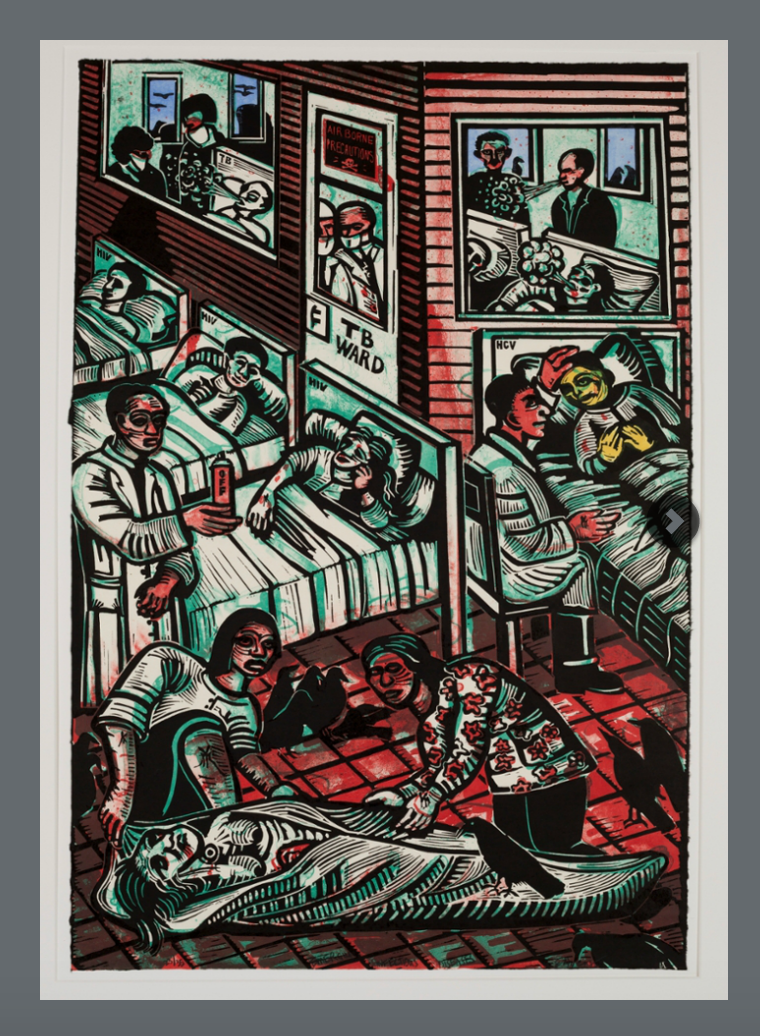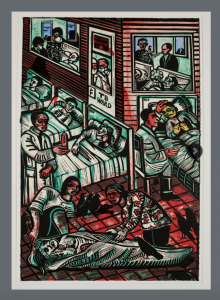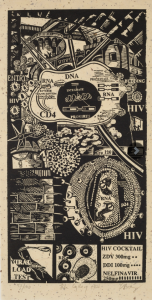Together.
Two prints hang side by side in a small gallery room. They either greet you as you walk in—the first rotation along the wall—or they fall into the blind spot abyss of the doorway.
Initially, the prints seem connected only by their subject matter. Two depictions of AIDS in the Block Museum’s exhibition “Keep the Shadow, Ere the Substance Fade: Mourning during the AIDS Crisis.” But over time you realize they are in constant conversation with one another—in a silent partnership balancing scales rather than creating something too heavy. Imagined by the same artist, the prints are two products of an experience. Parsed out for clarity, the different manifestations speak to the personal and impersonal sides of the AIDS pandemic.
Separate.
The first print Emerging Infectious Diseases (1999) has thick bold lines holding in washes of bright red and pops of an icy blue over a bright white backdrop. The colors bring life into the largely black and white exhibition and assert itself despite the proximity to the door—eliciting an interested gaze through its saturation alone. A single man to the right of the frame breaks the stark color scheme with his sickly skin tinged yellow by Hepatitis C. His disease is declared in all capital letters “HCV” on his headboard, his hands in loose prayer, his yellow face washed in faint blue and red.
As featured in other exhibition artworks, the print’s red recalls blood with powerful severity. However, the red is not only for wounds and fatalities. It’s barely on the patients at all. Rather, red colors the doctors’ faces, signaling a distinctly human issue—a connectedness, an empathy, a risk. The red could mean vitality or infection, nerves or humility, life or death. The unconventional use of the color only adds to the mysteries of the disease and the uncomfortableness with the unknown. While the print situates AIDS among other infectious diseases, no veil is lifted, no questions are answered.
Next to Emerging Infectious Diseases hangs Eric Avery’s second print, Life Cycle of H.I.V. (1999) The long rectangular print is a weathered beige stamped in opaque black ink. The color of the paper has an archival effect, one that evokes the sense of discovery inherent in a historical artifact rather than a piece of contemporary art. Avery channels a linguistic power, supported by the graphic novel look of his print. Bold illustrations of biological models and urban landscapes challenge all notions of scale and chronology. Negative space is rare, often infiltrated by dashes and lines contouring for a sense of depth in the flattest possible form.
The narrative element of the print is full of chutes and ladders. An announcement of “ENTRY” appears to be an explicit starting point, but once your eye completes the consumption you are led into a choose-your-own-adventure journey of tangled facts and figures. The maze is accented by the power of choice. If you choose to stick with only words, you lose the tiny lab-coated man—perhaps Avery himself since he was a medical doctor—with arms outstretched in guidance to the next form, or in surrender, or in glee. If you choose to follow the graphics alone, you undermine the clinicalness of Avery’s cyclical representation. Avery leaves Easter egg after Easter egg in each moment of his print only adding to the subjectivity of the piece’s impression and overall disorientation.
Together.
While both prints contextualize the disease in imaginative depth, their true emotional resonance is not in their depictions but instead in their compositions. There is a winding path of scale and story in the prints, a constant amount of zooming in and out required for a proper digestion of the pieces. An abundance of purposeful angles and curves do not merely form shapes, but act as the flippers of a pinball machine rapidly directing the eye from target to target, occasionally resting on an indecipherable symbol or image you are urged to confront. The cycle illustrated in Life Cycle of H.I.V. is not a clean cycle from a text book, it’s barely cyclical at all by sight alone. Emerging Infectious Diseases is not one hospital scene but a representation of all rooms of all wings in all hospitals. Nothing is certain, nothing is simple, nothing is easy about Avery’s compositions.
Separate.
Sometimes when looking at Emerging Infectious Diseases your eyes land on the stylized corpse of a woman as she is being zipped into a body bag. Both of the assisting nurses stare emotionless into your eyes out of the print, their pupils only suggested by shadows. They are red and wrinkled ironically becoming caricatures of “ill.” Sometimes your eyes zig zag and land on the one of the nurses’ scrub tops. Its bright red flowers’ round and organic shapes are a life form. The one sign of unthreatened life, outnumbered by the looming crows in the patients’ room and hospital windows, but more noticeable, more beautiful, more powerful.
The journey of Life Cycle of H.I.V. settles your gaze on the recipe for the HIV cocktail dosages or loses you in the detailed landscaping of the frame. Turrets and arches contrast the dark distressed bricks in the foreground detaching any specificity the viewer might search for. There is no reason to include a setting for the linguistic, scientific illustration yet Avery included them all. Tiny bodies in the landscape are erased without enough contrast or jump out in their black matte-ness reminding the viewer of the flat crows in Emerging Infectious Diseases. Sometimes your eyes settle on the artist’s handwriting toward the edge of the paper.
Together.
Eric Avery’s print compositions travel through all dimensions, planes, and facets of H.I.V. and AIDS. As the prints unfurl, Avery forces the viewer to confront the personified disease or the impersonal deaths mainly through their own wealth of experience and knowledge. As saturated with shapes, colors, words, diagrams, and symbols the prints may be, Avery still manages to leave a tiny pocket for the viewer to fill—completing the piece through their impressions, through what they notice. In the harmony of color and lines in Emerging Infectious Diseases or Life Cycle of H.I.V ‘s warm dissonant splays of black ink and aged paper, Avery creates a puzzling moment of meditation. In the time of urgent research, frantic searching, and ever generating questions, Avery successfully creates a welcoming complexity. The experience of being still rather than being lost.






85,474 Comments
After over 30 years in this business, we’ve learned a few things about what people like (and don’t like) about buying windows, doors & skylights. window replacement phoenix
Welcome to Supreme star tourism, your premier gateway to the wonders of the United Arab Emirates. We specialize in creating unique, immersive desert experiences that allow you to discover the true essence of the UAE. Dubai travel and tourism
See the complete Spanish league match schedule that we provide especially for you fans of the Spanish league and other top European leagues. We provide it in full for you only on our website here jadwal liga spanyol
Thank you for the information. I will offer you an online game story. I am new. Therefore, if you want to know more information, please visit our website https://jpmaxxx.com/
SUNWIN là trang web chuyên về các trò chơi game bài đổi thưởng nổi tiếng và lâu đời tại Việt Nam. Cổng game cung cấp các trò chơi hấp dẫn, tỷ lệ thắng cao và giao dịch nhanh chóng. Tham khảo link trang chủ SUN WIN tại https://www.hhstoday.com/
I saw this blog. it’s very good but the first picture has to much red color which make the picture is too red as well everything else is great ,the content and the other pictures were also very enjoyable while reading this article hot mail com
wep sayfanız gayet güzel tebrik ederim
https://www.iqostereamerkezi.com/
https://www.elektironikbuhar.com/
It’s an awesome article in support of all the web viewers; they will
take advantage from it I am sure.
It’s very straightforward to find out any topic on net
as compared to books, as I found this post at this site.